Oven baked trout with lavender and lemon: a healthy fish dish with a delicious flavour. Lavender and lemon is a classic combination, but did you know you can use it also for a baked whole trout? This lavender trout will captivate you with its delicate flavour!
Fish and the oven are best friends. Seriously the oven is a great appliance to always nail delicious fish cooked to perfection. It may not lend the smoky flavour of the grill, but baking or roasting fish in the oven is the easiest way to bring this healthy food option to your table. If you’re not eating enough fish and you need some motivation, this lavender baked trout is an easy recipe to begin with.
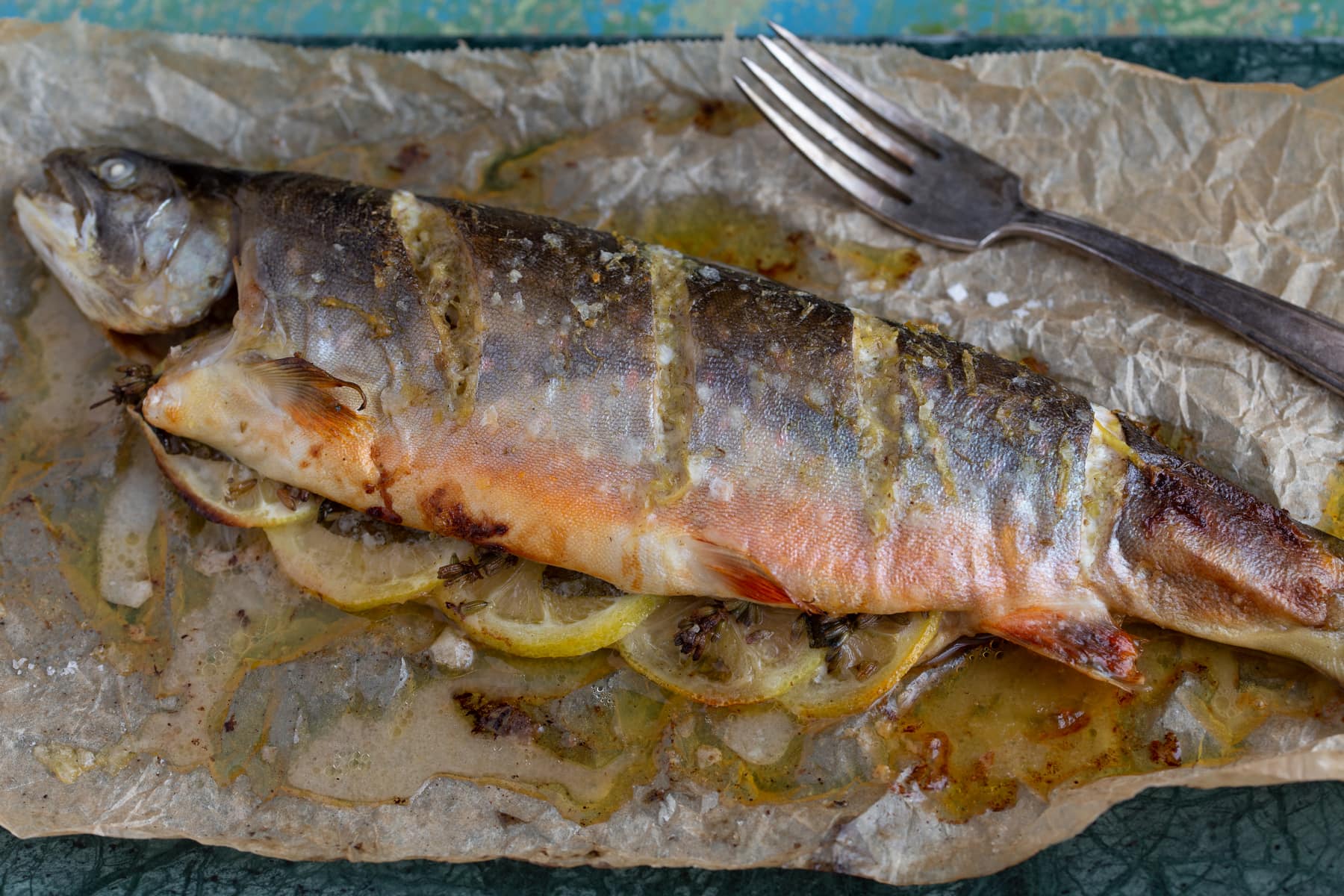
Baked whole trout
While it is very common and easy to buy fish fillets, largely available frozen, the fresh section of the supermarket also sells whole fish. The great thing is that they’re gutted and butterflied, ready to use! Butterflied means that the fish has been opened (on the belly) but the 2 sides are still attached on the back. Whenever my dad goes fishing he brings back gutted butterflied fish, so to me getting them like this is the closest to catching them myself.
The fish may be gutted, but most whole fish (especially smaller ones) will still come with the head and tail attached. Many people are intimidated by the idea of cooking a whole fish with head and tail on, but the truth is you just don’t need to do anything about them. Leave them on, and discard only when you will be removing the skin and bones. They will keep the stuffing sealed in, making for a perfect outcome.
Let’s get to this lavender baked trout recipe then!
Baked trout with lavender ingredients

- Whole trout – I am generically referring to trout in this post, but the fish I am using is actually an arctic char. Lake trout or arctic char are the most easily found types of this fish, but any salmonid fish (of the Salvelinus genus) will work great in this recipe. Rainbow trout is another great one, but they can be larger so you will need to make some adjustments. This fish weighed 500 g.
- Butter
- Lavender – check that it is the culinary type, like English lavender.
- Lemon
- Garlic
- Sage – fresh leaves preferred, but dry will work as well.
- Salt – flakes preferred, but regular table salt is also fine.
Quantities and detailed instructions are in the recipe card at the bottom of this post. Read on for step-by-step instructions and process pictures.
How to prepare lemon lavender trout
The first thing to do is to prepare the lemon lavender butter.
- Lightly crush the dried lavender flowers in a mortar and pestle set.
- Peel and crush the garlic clove.
- Zest the lemon.
- Combine room-temperature butter, crushed lavender, garlic and lemon zest and work the herbs in with your fingers until you get a homogeneous compound butter.

How to make lavender trout
Place the whole trout on a baking sheet lined with parchment paper. Gently open the fish where it has been butterflied and sprinkle a generous amount of salt. Stuff the inside of the fish with lemon slices, lavender sprigs and sage leaves, then “close” the fish back. Stuffing and salting the inside is a great way to get a lot of flavour, but often most of it will only be transferred to the side of flesh below the stuffing.
To flavour the upper side make 3 or 4 cuts on the diagonal about 1 cm deep. How deep and how many you will make depends on the size of your fish, but this is a guideline with a fish like the one I used in these pictures.
Stuff the cuts with the lemon lavender compound butter you have prepared. Push in as much as you can fit. Spread the butter leftovers all over the skin on the side of the fish that will be facing upwards. If you still have leftovers, chuck any compound butter that’s left inside the fish with the rest of the stuffing.

Bake in the preheated oven at 200°C (390°F) for about 30-35 minutes. Baking time will depend on the size of the fish and the oven. I have used mine on fan forced setting.
What temp should trout be cooked to?
To check for doneness gently lift the top side of the fish and check if the flesh looks opaque and flaky. That is a sign of doneness. If you have a meat thermometer you can check the internal temperature: it should be 60°C (145°F).
Take the baked trout out of the oven and allow it to rest for 10 minutes before digging into it. This is a general rule that is valid both for meat and fish, as it helps to redistribute the juices once cooking is done.
How to serve the baked trout
The first thing you want to do is cut off the head just above the fins. Use a chef’s knife, it should be a rather easy procedure as the spine should break easily under the knife.
Cut the skin of the fish all along the back, starting from the (missing, now) head all the way to the tail. Proceed to peel off the skin from the fish, it should come off very easily. Remove the tail along with the skin. Now the top fillet is exposed. Gently slide it off the bones, placing cooked fish on a serving plate.
When you have taken all the flesh from the top side, grab the spine from the head side and gently pull. It should come away very easily from a cooked fish. Discard, and proceed to remove the cooked herbs that had been stuffed into the fish. Carefully remove any single fishbones that have detached from the spine. Now you can lift off the meat from the bottom fillet and transfer to a serving plate.

Can you eat the skin of baked trout?
Yes, if the fish has been properly descaled you can eat the skin. Most of the time any fish commercially sold (gutted and butterflied) will also be descaled. People who catch their fish themselves usually have descaling among their routines, too, so if you got a fresh catch from a friend or family member chances are it has been done.
The skin of the fish is rich in omega-3 fatty acids just like the rest of the fish, so eating it will provide extra beneficial nutrients. We are spreading the compound butter all over the skin of the fish, so the side that has been facing upward will have a nicely crispy skin. I personally am not a fan but I recommend you give it a try and taste for yourself. It comes with the whole package anyway.
What to serve with it
As shown in these pictures, asparagus is a lovely pairing. Its fragrant taste is a great complement to the delicate fish, making it a summer Mediterranean meal. Try white wine asparagus or asparagus risotto.
For another vegetable side, my caramelized butter sautéed carrots are a sweet note. If you are looking for something more filling, basil ricotta pasta salad is a lovely option.
For a warm sauce that will up the lemon flavour try the one in my creamy cod. For a cold alternative, I swear by saffron garlic mayo! Mayo is great with fish, and saffron makes everything just so much more interesting!
If you make my baked trout recipe with lemon and lavender let me know in the comments! And don’t forget to pin this recipe for later!

This recipe was originally published in August 2016. Updated May 2021 with new images, new text and a recipe card.
Baked trout with lavender and lemon
Ingredients
- 1 whole trout/char 500 g gutted
- 30 g butter room temperature
- 1 tsp dried lavender + extra sprigs for stuffing
- 1/2 lemon zested and sliced
- 1 garlic clove
- 1 sage sprig
- salt flakes
Instructions
- Lightly crush the dried lavender flowers in a mortar and pestle set. Peel and crush the garlic clove. Zest the lemon. Combine these ingredients with the room temperature butter and work the herbs in with your fingers until you get a homogeneous compound butter.
- Place the whole trout on a baking sheet lined with parchment paper. Gently open the fish where it has been butterflied and sprinkle a generous amount of salt. Stuff the inside of the fish with lemon slices, lavender sprigs and sage leaves, then "close" the fish back.
- Make 3 or 4 cuts on the diagonal on the side of the fish that is facing up, about 1 cm deep. How deep and how many you will make depends on the size of your fish.
- Stuff the cuts with the lemon lavender compound butter you have prepared, pushing in as much as you can fit. Spread the butter leftovers all over the skin of the fish. If you still have leftovers, chuck any compound butter that's left inside the fish with the rest of the stuffing.
- Bake in the preheated oven at 200°C (390°F) for about 30-35 minutes. Baking time will depend on the size of the fish and the oven. I have used mine on fan forced setting. To check for doneness gently lift the top side of the fish and check if the flesh looks opaque and flaky. That is a sign of doneness. You can also check the temperature: it should be 60°C (145°F).


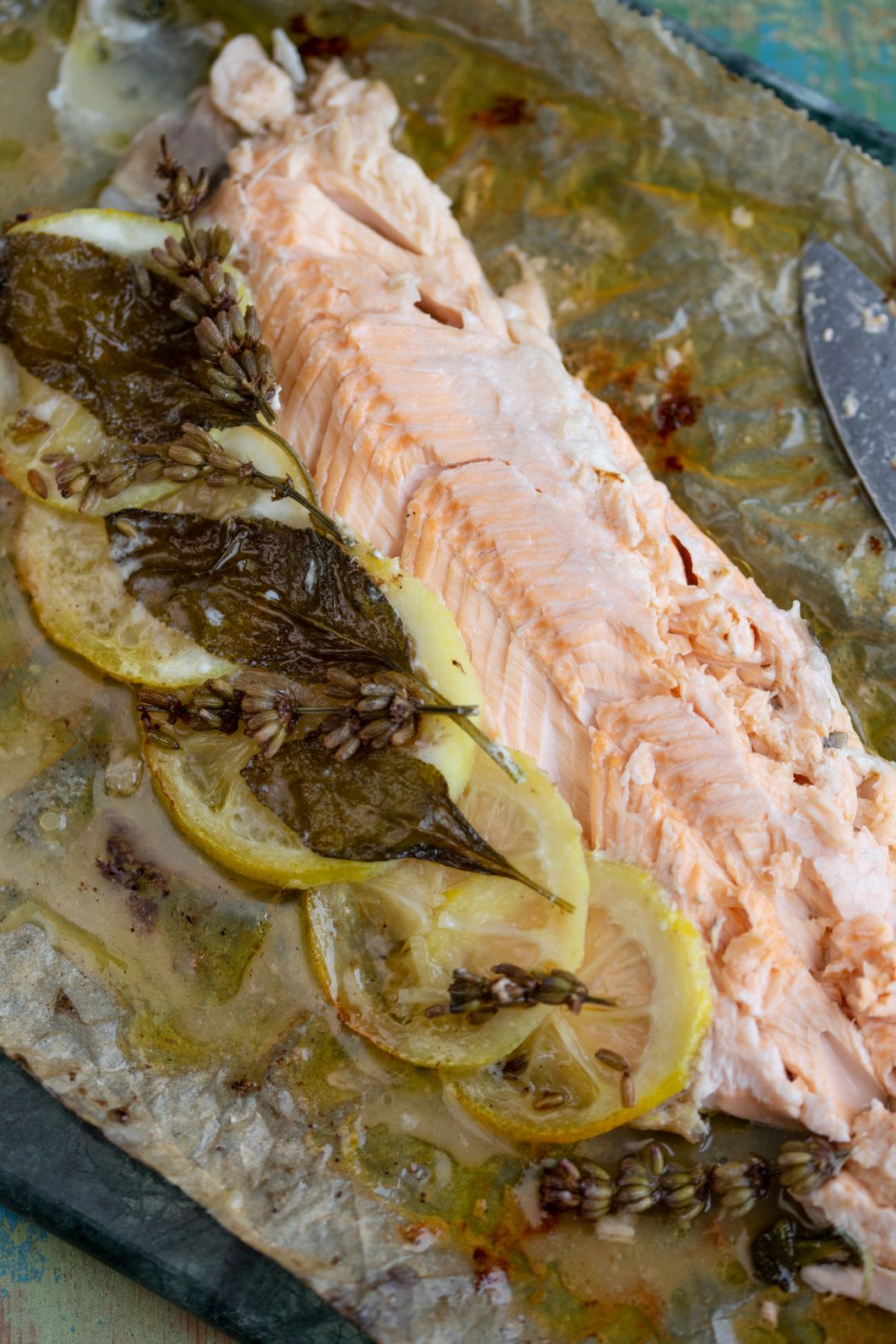
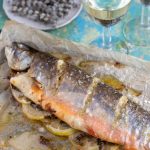
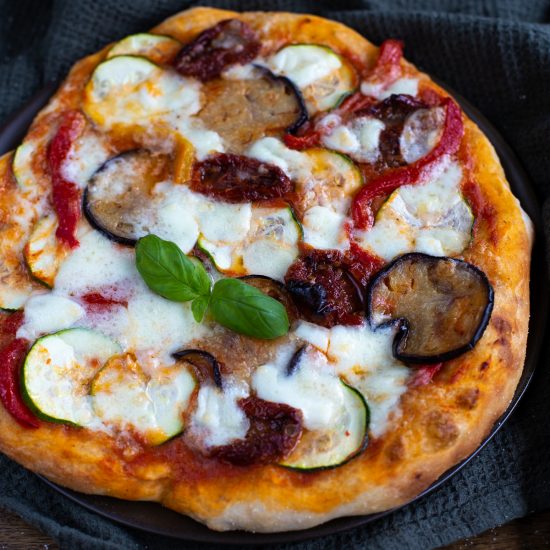
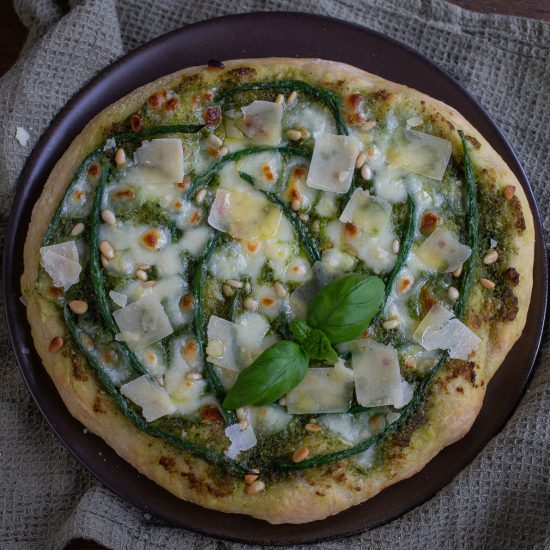

I am so intrigued and impressed! There’s something decidedly cool about catching your own food, and the use of lavender salt – inspired! I’ve never used it before, but I have tons of lavender in my garden… I wonder if I can dry it and add salt? What do you think? GREAT post and fabulous pics!
I think it would work, absolutely! That’s basically what it is: dried lavender flowers and salt. I think the nice thing about the one I brought back from France (apart from being fancy Provence lavender :P) is that it has a grinder. Freshly ground, the dried flowers release their full potential, so if I were you I’d keep it in a grinder for best results.
Thanks for stopping by and let me know if you end up making your own lavender salt!!
Thanks Eva, I will definitely try, and I happen to have a few empty grinders lying around. I’m excited to try it!
This looks and sounds just beautiful!
Aww thanks 🙂